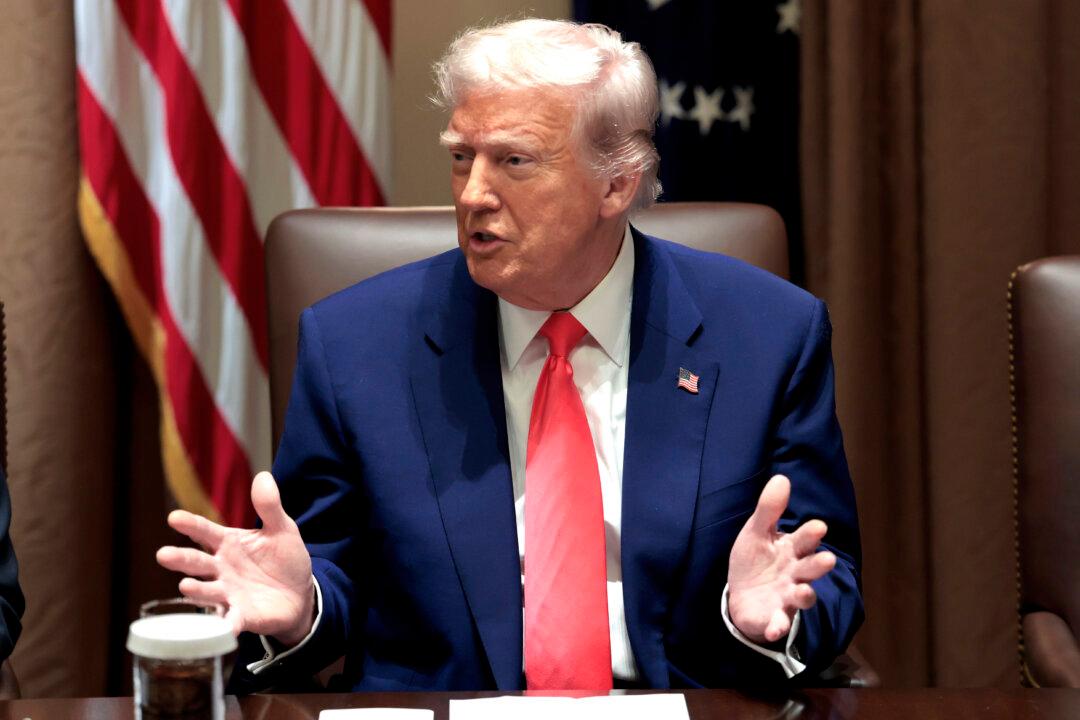April 9 marks a watershed moment in U.S.–China relations. That’s the view of Mike Sun, a U.S.-based businessman with decades of experience advising foreign investors and traders doing business in China.
On this date, China hit the United States back with an extra 50 percent in tariffs, the third round of retaliations from Beijing. Later, Trump raised tariffs on China to a total of 145 percent while pausing higher levies on all other countries. China then raised tariffs on the U.S. to 125 percent.
The Chinese regime has crossed the threshold from being a mere strategic competitor of the United States and started moving toward enemy status, like the Soviet Union during the Cold War, according to Sun.
Cold War or not, the experts we spoke to agreed that U.S.-China relations have turned a page.
The tariff standoff is at its core a battle over the world economic order, experts say, and neither Beijing nor Washington will accept living in a future where the other party sets the rules.
There’s little room for meaningful negotiations between the United States and China anymore, and now it’s time to see which side other economic powers side with, according to these specialists.
During the previous Trump administration, China proposed to buy American products. Sun said this addressed Trump’s need to reduce the trade deficit between the two countries. The negotiations led to the “phase one” trade agreement signed in January 2020, which Beijing didn’t fulfill.
This time, however, the game is different.
Citing the goal of achieving reciprocity with all countries, Trump is seeking to rebuild the global economic order, Sun said.
“The Chinese Communist Party has seen the difference between Trump’s current and previous approaches, too,” Sun told The Epoch Times.
“The regime has seen that making concessions to the United States would lead to a future it cannot stomach, so it has chosen to fight.”
While Americans may protest against Trump’s policies on the streets, it’s unlikely that the world will see demonstrations in Shanghai, Beijing, or Guangzhou. And China’s leader Xi Jinping doesn’t have to worry about voters. Trump needs to improve U.S. job numbers and inflation to continue holding out in the tariff stare-down contest with Xi.
The communist party general secretary isn’t free of pressure, either. Ultimately, if China’s economy, which is increasingly dependent on exports, becomes worse, the Chinese Communist Party elites may support another leader. There was a precedent in history.
Hence, invading Taiwan remains a viable option for Xi to turn the tables, according to China expert Alexander Liao.
The Chinese military has recently issued an internal communique focused on the following three points, which he learned from his insider access to the People’s Liberation Army (PLA).
First, a war on Taiwan is bound to happen. The situation may be similar to the Korean War, during which peace talks, which lasted more than two years, were held concurrently with the fighting.
Second, a war between China and the United States is a large possibility.
Third, the PLA distributed the insignia of the various branches of the U.S. military for Chinese soldiers to study so they could tell the enemy’s branch in battles.
“The atmosphere is quite tense in the PLA,” Liao said.
“A war can solve many problems for Xi: first, the economy wouldn’t matter so much anymore; second, he could calm down his opposing factions within the CCP and give the Chinese people an external reason to justify the rule of the Communist Party.”
—Terri Wu
WHAT'S NEXT FOR THE BUDGET PLAN
The House of Representatives on April 10 approved the budget blueprint to implement President Donald Trump’s agenda, overcoming a substantial procedural hurdle after days of uncertainty.
The resolution, approved in a narrow 216–214 vote, authorizes relevant committees in both chambers of Congress to begin work on drafting the legislation under the rules of the restrictive reconciliation process.
The passage of the resolution represents a hard-won victory for both House Speaker Mike Johnson (R-La.) and Senate Majority Leader John Thune (R-S.D.), who both worked over the course of several meetings on Capitol Hill and at the White House to win over reluctant conservatives.
Still, the resolution’s approval by the lower chamber is only the first step in what will be a lengthy process to draft and pass Trump’s “big beautiful bill.”
The final legislation is expected to wrap in provisions related to tax policy, funding for energy, defense, and homeland security, spending cuts, and various other provisions.
Republicans are using the reconciliation process to pass the legislation, which allows them to bypass the 60-vote filibuster threshold that makes most partisan legislation dead on arrival in the Senate.
The passage of the resolution through both houses means that Congressional leaders will begin drafting the bill in line with its top-line terms.
Homeland Security, encompassing immigration enforcement, will get between $90 and $175 billion of new funding.
The resolution also authorizes around $100 billion and $150 billion in new defense spending.
Additionally, the bill will authorize a between $4 trillion and 5 trillion debt limit increase to avert a default by the United States later this year.
Most Republicans support the broad outlines of these objectives—but a handful of provisions in the Senate’s instructions have been divisive.
The extension of the 2017 tax cuts will be the priciest item in the bill, costing up to $4.5 trillion.
But in the Senate’s instructions, as little as $4 billion in enforceable spending cuts are ordered.
Conservatives have received assurances that the tax cuts will be linked to spending cuts and that the final legislation will not increase the deficit. But critics have made clear that they’ll still tank the final product if these assurances aren’t met.
The budget resolution instructs the House Energy and Commerce Committee to cut $880 billion over a decade, a level that would necessitate cuts to the Medicaid entitlement program.
Some Republicans have expressed concerns about cuts to the program—particularly those in purple districts in states like New York and California.
Others are concerned about a provision in the Senate instructions that could raise the debt ceiling by $5 trillion—a bridge too far for many conservatives.
Republicans are on a timeline to bridge these controversies, as passage of any major legislative package will only get more difficult as the 2026 midterms approach.
“People would be more timid next year than this year because there'd be an election year. So this is the time. This is it. We don’t have another bite at the apple,” said Rep. Richard McCormick (R-Ga.).
—Joseph Lord, Jackson Richman, and Arjun Singh
BOOKMARKS
Health Secretary Robert F. Kennedy Jr. wants to learn the root cause of surging autism rates, and he is launching a “massive” new project to do so. “By September, we will know what has caused the autism epidemic, and we'll be able to eliminate those exposures,” Kennedy said recently.
More than 70 House Democrats have signed a letter demanding reassurance from Donald Trump that Elon Musk will be out of the federal government by May 30. It’s unclear what they plan to do if Trump refuses, and the White House has not responded publicly.
The United States has struck a deal with Panama to curtail security concerns raised by the Chinese Communist Party’s activity around the Panama Canal. China’s “growing and adversarial control of strategic land and critical infrastructure in this hemisphere” is over, Defense Secretary Pete Hegseth said on April 9.
The House passed a bill 220–208 on Thursday requiring proof of citizenship to vote, with four Democrats joining all Republicans to push the measure through. The bill faces a tougher battle in the Senate, where it will require 60 votes to overcome a filibuster, but the GOP only holds 53 seats.
Commissioner Jocelyn Samuels is suing the Trump administration, which fired her from the Equal Employment Opportunity Commission in January, alleging she tried to “impose an expansive and improper DEI agenda on America’s workplaces.” Her lawyers argue that Trump lacked cause to fire her, but a White House spokeswoman told The Epoch Times in an email that: “The Constitution gives President Trump the power to remove personnel who exercise his executive authority.“
—Stacy Robinson






